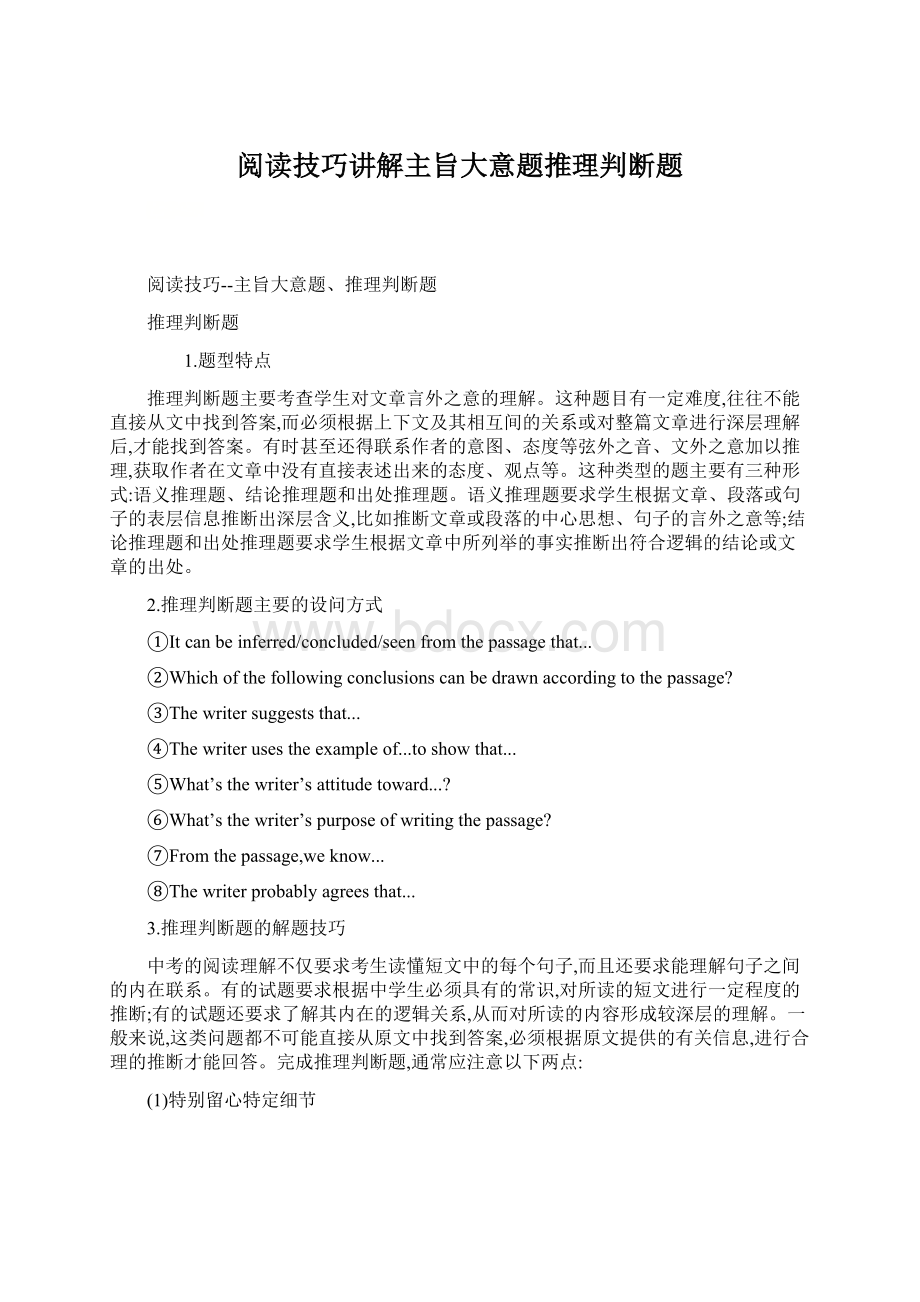阅读技巧讲解主旨大意题推理判断题.docx
《阅读技巧讲解主旨大意题推理判断题.docx》由会员分享,可在线阅读,更多相关《阅读技巧讲解主旨大意题推理判断题.docx(23页珍藏版)》请在冰豆网上搜索。

阅读技巧讲解主旨大意题推理判断题
阅读技巧--主旨大意题、推理判断题
推理判断题
1.题型特点
推理判断题主要考查学生对文章言外之意的理解。
这种题目有一定难度,往往不能直接从文中找到答案,而必须根据上下文及其相互间的关系或对整篇文章进行深层理解后,才能找到答案。
有时甚至还得联系作者的意图、态度等弦外之音、文外之意加以推理,获取作者在文章中没有直接表述出来的态度、观点等。
这种类型的题主要有三种形式:
语义推理题、结论推理题和出处推理题。
语义推理题要求学生根据文章、段落或句子的表层信息推断出深层含义,比如推断文章或段落的中心思想、句子的言外之意等;结论推理题和出处推理题要求学生根据文章中所列举的事实推断出符合逻辑的结论或文章的出处。
2.推理判断题主要的设问方式
①Itcanbeinferred/concluded/seenfromthepassagethat...
②Whichofthefollowingconclusionscanbedrawnaccordingtothepassage?
③Thewritersuggeststhat...
④Thewriterusestheexampleof...toshowthat...
⑤What’sthewriter’sattitudetoward...?
⑥What’sthewriter’spurposeofwritingthepassage?
⑦Fromthepassage,weknow...
⑧Thewriterprobablyagreesthat...
3.推理判断题的解题技巧
中考的阅读理解不仅要求考生读懂短文中的每个句子,而且还要求能理解句子之间的内在联系。
有的试题要求根据中学生必须具有的常识,对所读的短文进行一定程度的推断;有的试题还要求了解其内在的逻辑关系,从而对所读的内容形成较深层的理解。
一般来说,这类问题都不可能直接从原文中找到答案,必须根据原文提供的有关信息,进行合理的推断才能回答。
完成推理判断题,通常应注意以下两点:
(1)特别留心特定细节
所谓“特定细节”,就是问题所涉及的范围和对象中的细节事实,一般包括事实根据、名字(人物或地点)、数字(日期或统计数字)、关键词语的其他表达方法(同义词、近义词、反义词)等。
(2)注意作者的语气和态度
作者的语气和态度通常体现在短文所使用的措辞和句式上。
要特别注意感情色彩比较浓重的形容词和副词,特别留心短文句子的长度和结构。
从措辞上我们可以推断出作者对所讨论话题的态度;从句式的长短和结构可以判断出作者讨论问题的语气。
三、主旨大意题
1.题型特点
要求在阅读和理解全文的基础上对文章进行归纳、概括或评价。
解答这种题型时,不能只凭文中的只言片语而断章取义,比如涉及文章的标题(title)、主题(mainidea)、结论(conclusion)、结局(end)等有关问题,都需要在细读全文的基础上,结合所学语言知识、背景知识、生活常识等进行逻辑推理和判断,从而挖掘出文章中隐含的信息。
2.主旨大意题主要的设问方式
①What’sthemainideaofthispassage?
②Whatisthepassagemainlyabout?
③Whatdoesthepassagemainlydiscuss?
④Thewritermeanstotellusthat .
⑤Themainideaofthepassageisthat .
⑥Thepassageismainlyabout .
⑦Fromthepassagewecanlearn/concludethat .
⑧Thelastparagraphischieflyconcernedwith .
⑨What’sthebesttitleforthepassage?
⑩Whatwouldbethebesttitleforthepassage?
Thebesttitleforthepassageis .
3.主旨大意题的解题技巧
(1)留心关键词,抓住文章主旨;串联主要细节,推断文章中心思想。
所谓关键词,即文章中反复出现的、与主题有关的实词,如名词、动词等。
冠词或介词等虚词均不在关键词之列。
需要注意的是,为了避免同一词的过多重复,文章有时会使用这个词的同义词、近义词,或用代词指代。
我们知道,并不是所有文章都包含明确的主题句,比如大多数记叙文。
记叙文的中心思想多隐藏在具体的细节中,作者通过众多的细节事实对一个中心点进行论述。
因此,我们必须善于串联主要细节,从中归纳文章的中心思想。
(2)注意段落主题句,归纳文章大意。
段落的主题通常由被称为主题句(TopicSentence)的句子来表示。
主题句有两个功能:
①介绍段落的主题(Topic);②阐述控制概念(ControllingIdea),控制概念用以控制段落中句子讨论的内容。
主题句通常是一段的第一句或末尾一句,偶尔在一段中间。
我们在阅读非故事性文章(如科普文章)的时候,主题句尤为明显。
有的文章无明显的主题句,主题句隐含在段意之中。
①主题句位于段首
主题句位于段首是由作者先立论,后摆事实讲道理的写作手法形成的。
这种段落称作演绎型段落。
据有关统计数字表明,在英语议论文或说明文中,有60%~90%的主题句是段落的第一句。
a.寻找主题句
有些段落,有明显的引出细节的信息词,常见的信息词有:
forexample,anexampleof,themostimportantexample,first,second,next,then,last,finally,tobeginwith,also,besidesthat等。
在阅读中,应尽量利用上述信息词确定主题句的位置。
从段落中的forexample可以断定,前一句话是主题句。
如果无明显的信息词,可先假设第一句话为主题句,在第二句话前面添加一个forexample,看看第二句话是否可以支撑第一句话,如果第二句话不能支撑第一句话,便在其他地方找出主题句。
b.选择答案
先彻底弄懂主题句的句意,然后阅读所给的选项,选择与主题句句意相吻合的答案,如主题句的再现,主题句句意的转述或推论等,排除与主题句句意无关的答案,如支撑细节和文章中未曾阐述的事实等。
②主题句位于段末
主题句位于段末是作者采用了先摆事实,后做结论的手法。
这种段落称作归纳型段落。
③主题句位于段落的中间
主题句偶尔也出现在段落的中间,但不一定就在正中间。
有时,第一句并非主题句,而是承上启下的过渡句。
在这种情况下,第二句便成了主题句。
此外,主题句也可能是段落的倒数第二句。
真题训练
一
ArecentstudyfromateamofSouthKoreanresearcherssuggeststhateatingaloneoftenmayleadtopooreatinghabitsandpoorfoodchoices.Specifically,thestudyfoundthatmenwhoatealonemorethantwiceaweekhadagreaterriskofdevelopinghighbloodpressure,highcholesterolanddiabetes.
Forchildren,eatingwiththeirfamiliesisnotonlyaboutpreventingbadoutcomes(结果)—itisalsoaboutdevelopinggoodones.
In2014,theOrganizationforEconomicCooperationandDevelopment(OECD)lookedatdatafromnearlythree-quartersoftheworld’scountries.Amongitsfindingswasthefactthatstudentswhosharedamainmealwiththeirfamilieswerelesslikelytoskipschool.Childrenwhoeatamainmealwiththeirfamiliesarealsolesslikelytoabusedrugsandalcohol(吸毒酗酒).
Inthereport,titled“TheImportanceofFamilyDinners(Ⅷ)”,researcherssaythat“teenswhohavefrequentfamilydinnersaremorelikelytosaytheirparentsknowalotaboutwhat’sgoingonintheirlives”.Theyalsoclaimthatwhenteenssaytheyfeelclosertotheirparents,theyarelesslikelytousedrugsandalcohol.
AnotherstudyfromtheUniversityofMontrealfoundthatchildrenwhoatewiththeirfamiliesexperiencelong-termphysicalandmentalhealthbenefits(好处).Thesechildrenwerephysicallyinbettershapeanddrankfewersugarysoftdrinks.Thesechildrenalsoseemedtohavebettersocialskillsandtheywerelessaggressive(好斗的).
ProfessorLindaPaganisaysthatmealtimessharedwithparents“likelyprovideyoungchildrenwithfirst-handsocialinteractions,discussionsofsocialissues(事件)andday-to-dayconcerns”.Sheaddsthattheymaylikelyhelpthechildhavebettercommunicationskillswithothers.
1.Whatcanbethebesttitleforthetext?
A.Benefitsofeatingtogether.
B.Advantagesofeatingalone.
C.Waysofdevelopingsocialskills.
D.Risksofusingdrugsandalcohol.
2.Childreneatingwiththeirfamiliesaremorelikelyto .
A.drinkmoresugarysoftdrinks
B.dowellintheirstudiesatschool
C.bemoresociallyactiveandaggressive
D.haveacloserrelationshipwiththeirparents
3.WhyisProfessorPaganimentionedinthelastparagraph?
A.Tointroduceher.
B.Toaddanewpoint.
C.Toexplainfurther.
D.Toprovidebackgroundinformation.
4.Fromwhichisthetextprobablytaken?
A.Atravelguide.
B.Abiologytextbook.
C.Acookinginstruction.
D.Asciencemagazine.
1.【答案】A
【解析】主旨大意题。
本文主要讲与家人一起吃饭的好处,题目应该与此相关,故选A。
2.【答案】D
【解析】细节理解题。
由第四段的最后一句话“Theyalsoclaimthat...totheirparents...”可知经常和家人吃饭的孩子与父母之间的关系更亲密,由此可知本题选择D。
3.【答案】C
【解析】推理判断题。
最后一段提到她并且引用了她说的话,都是对前面观点的进一步解释,故选C。
4.【答案】D
【解析】推理判断题。
本文介绍了一项研究的结果,应该属于科学杂志刊登的内容,故选D。
二
Areyouafraidofgoingtothedentist(牙医)?
Ifso,you’renotalone.
Thesefearscouldjustbeinourheads,however.AccordingtoarecentsurveybyMartinTickle,aprofessorattheUniversityofManchesterintheUK,thepainisn’tfeltmostofthetimeindentalsurgeries(牙科手术).Infact,amongthe451interviewedpatients,75%reportednopainatallduringtheirvisits,includingsituationswhentheyhadtheirteethpulledout.
Coulditbethesoundofthedrill(钻头)then?
“Ifoundthatthesoundofdrillingcanevokedeepworryindentalpatients.Actuallytheydon’thaveanypain,”HiroyukiKaribe,ascientistatNipponDentalUniversityinTokyo,toldTheGuardian.
Tofindthereasonwhyadrillmightbringonaracingheart,Karibedividedthevolunteersintolow-fearandhigh-feargroupsbasedonhowmuchtheyfearedatriptothedentist.Volunteerswereplayedthesoundofadrillwhiletheirbrainactivitieswerewatchedbyamachine.
WhatKaribefoundinthelow-feargroupwasincreasedactivityintheareasofthebrainrelativetoauditoryprocessing(听觉处理),whichmeans,forthesepeople,thesoundofdentaldrillsisnodifferentfromothersounds.
Inthehigh-feargroup,however,thebrainareathatwasactivated(激活)wasdifferent.Itwastheareathatcarriesoutanumberofduties,includinglearning,feelingsand,mostimportantly,memory.Thismeansthatthesevolunteersnotonlyheardthesound,buttheyrememberedit—theymadeconnectionsbetweenthesoundofadrillandtheworryitproducedinthepast,causingtheirworrytoreturn.
Understandinghowbrainsreplytothesoundsofdentists’drillscouldhelpscientistsfindwaystomakepatientsmorerelaxed,accordingtoKaribe,becausepatientswhoworryaboutgoingtothedentistmightkeepputtingofftheirvisits.Butthebestwayistokeepyourteethhealthy.
根据短文内容,选择最佳选项。
1.Howdoesthewriterexplainthatthepainisn’tfeltmostofthetimeindentalsurgeries?
A.Byshowingfactswithnumbers.
B.Byaskingquestionsonebyone.
C.Bygivingexamplesgroupbygroup.
D.Bycomparingresultsofpatients.
2.Accordingtothefourthparagraph,whatdoestheword“evoke”meaninChinese?
A.减轻B.引起C.显示D.阻止
3.Howdidthesoundofdrillingproducedifferentresultstothevolunteersinthestudy?
A.Itproducedsomeworryinthevolunteersinthelow-feargroup.
B.Forthelow-feargroup,itactivatedthebrainareadealingwithlearning,feelingsandmemory.
C.Forthehigh-feargroup,itcausedmoreactivitiesinthebrainarearelativetoauditoryprocessing.
D.Itmadepeopleinthehigh-feargroupremembertheirpastuncomfortablememories.
4.Whatisthelastparagraphmainlyabout?
A.Howthestudymightbeuseful.
B.Somenewwaystotreatteeth.
C.Theproperwaytotreatdentalpatients.
D.Theimportanceofkeepingourteethhealthy.
5.What’sthepurposeofthepassage?
A.Toshowusdifferentareasoffearinbrains.
B.Tointroduceusarecentsurveybyascientist.
C.Tohelpushavelessfearofatriptothedentist.
D.Tomakeitclearthatthesoundofdrillingisnotterrible.
1.【答案】A
【解析】推理判断题。
题干意为:
作者是如何解释在牙科手术中,疼痛并不是大多数时候都能被感觉到的?
根据文中第二段的最后一句“Infact,amongthe451interviewedpatients,75%reportednopainatallduringtheirvisits,includingsituationswhentheyhadtheirteethpulledout.”可知,作者是通过这一组数字告诉我们他的这个观点的。
故本题选A。
2.【答案】B
【解析】词义猜测题。
题干意为:
根据文章第四段,“evoke”一词的中文意思是什么?
根据文中第四段中的“Ifoundthatthesoundofdrillingcanevokedeepworryindentalpatients.Actuallytheydon’thaveanypain”可知,作者认为,是钻孔的声音“引起”了牙科病人的担心,而事实上并不疼。
其他选项的意思都不合适。
故本题选B。
3.【答案】D
【解析】细节理解题。
题干意为:
在研究中,钻孔的声音是如何对志愿者们产生不同的结果的?
根据文中倒数第二段的内容可知,在“high-fear”组,大脑带有“学习、情感、记忆”等功能的这部分被激活,这就意味着这些志愿者们不仅听到了声音,而且记住了声音,他们把这种钻头的声音与过去产生的担忧联系起来,导致了“害怕”的反射。
故D选项符合题意。
4.【答案】A
【解析】主旨大意题。
题干意为:
文章的最后一段主要是关于什么?
根据文中最后一段的内容可知,了解大脑如何对牙医的钻牙声做出反应,可以帮助科学家找到使病人放松的方法,因为病人总是担心,会讳疾忌医。
因此,最后一段是想告诉我们,这项研究是非常有用的。
故A选项符合题意。
5.【答案】C
【解析】推理判断题。
题干意为:
这篇文章的目的是什么?
根据全文内容可知,作者通过实验,寻找是什么原因引起牙科病人的恐慌,目的是找到方法让牙科病人减少去看牙医的恐惧。
因此,文章的写作目的是“Tohelpushavelessfearofatriptothedentist.”,故本题选C。
三
Fromayoungage,I’vehadareallydeepconnectionwithbeingoutside.I’vebeenskiingsinceIwaseightornineyearsold.I’vebeenonexpeditions(探险)inmanyplaceslikeChina,Pakistanandsoon.Butitwasinmyhom